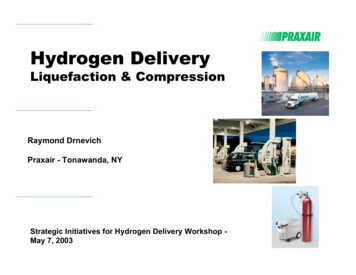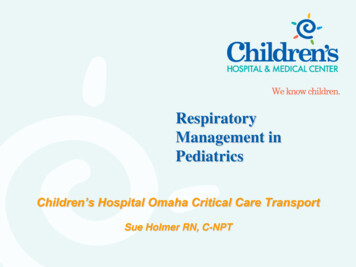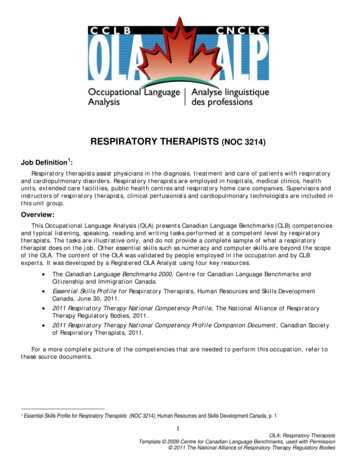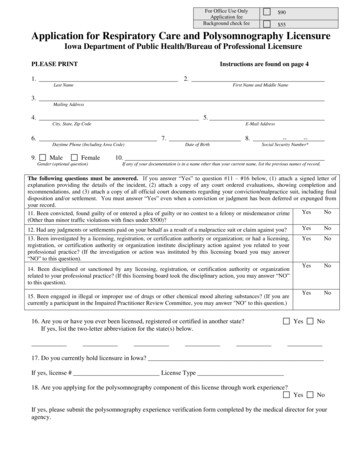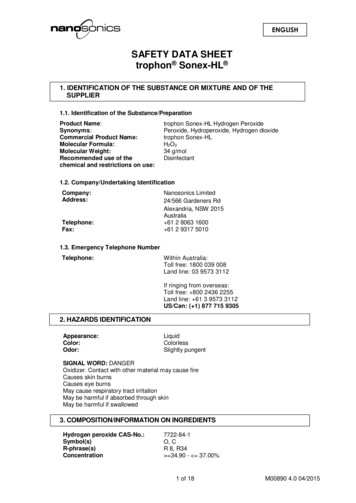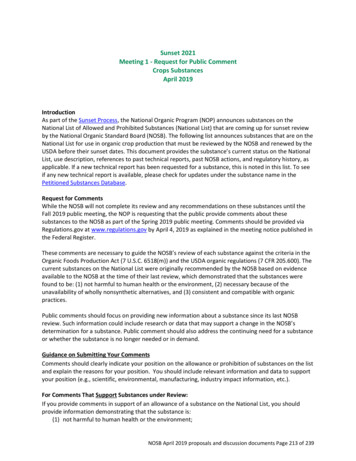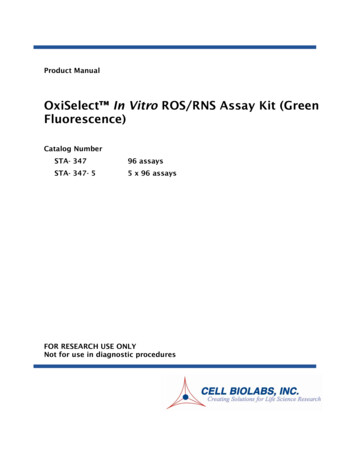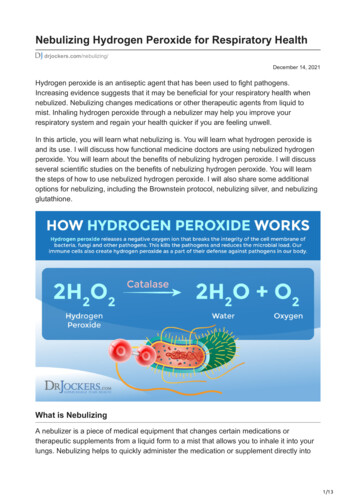
Transcription
Nebulizing Hydrogen Peroxide for Respiratory Healthdrjockers.com/nebulizing/December 14, 2021Hydrogen peroxide is an antiseptic agent that has been used to fight pathogens.Increasing evidence suggests that it may be beneficial for your respiratory health whennebulized. Nebulizing changes medications or other therapeutic agents from liquid tomist. Inhaling hydrogen peroxide through a nebulizer may help you improve yourrespiratory system and regain your health quicker if you are feeling unwell.In this article, you will learn what nebulizing is. You will learn what hydrogen peroxide isand its use. I will discuss how functional medicine doctors are using nebulized hydrogenperoxide. You will learn about the benefits of nebulizing hydrogen peroxide. I will discussseveral scientific studies on the benefits of nebulizing hydrogen peroxide. You will learnthe steps of how to use nebulized hydrogen peroxide. I will also share some additionaloptions for nebulizing, including the Brownstein protocol, nebulizing silver, and nebulizingglutathione.What is NebulizingA nebulizer is a piece of medical equipment that changes certain medications ortherapeutic supplements from a liquid form to a mist that allows you to inhale it into yourlungs. Nebulizing helps to quickly administer the medication or supplement directly into1/13
your lungs. Nebulizers have a mouthpiece or face mask to put over your face to inhalethe mist through it. The therapeutic agent then goes straight into your respiratory systemand lungs exactly where you need it to take effect.Nebulizers are often recommended for people with asthma or other respiratory issues.They may be used for acute respiratory infections. As you will learn from this article,nebulizing with hydrogen peroxide is a safe way to naturally support your health if youhave a respiratory infection.Nebulizers are highly affordable. Home nebulizers start at around 50. They are largerand you have to plug them into a wall electrical outlet to use. Portable nebulizers areslightly more expensive, but smaller and run on batteries making them an easy option fora busy lifestyle.What is Hydrogen PeroxideHydrogen peroxide (H2O2) is a mild antiseptic agent that is made up of two hydrogenatoms and two oxygen atoms. Hydrogen peroxide releases oxygen when applied toaffected areas, which causes foaming. This is because the blood and most living cellscontain the enzyme catalase, which attacks hydrogen peroxide and converts it into water(H20) and oxygen (O2).The free oxygen radical has a negative charge that interacts with pathogens anddamages their cell walls. This helps to destroy bacteria, clean areas, and remove deadskin cells. Your white blood cells make and use hydrogen peroxide to fight bacteria,viruses, fungi, and other pathogens.2/13
Hydrogen peroxide has been long used as an accepted, safe, and affordable disinfectantfor surfaces, cuts, scrapes, burns, and minor wounds. It may also be beneficial as amouth rinse that helps to relieve canker sores, gingivitis, and other minor mouth irritationand reduce mucus. Furthermore, hydrogen peroxide may be beneficial for your sinus,lung, and overall respiratory health.It turns out that the friendly bacteria in the mucous membranes of your lungs, sinuses,nose, mouth, digestive system, and urinary tract thrive in environments that are rich inoxygen. Hydrogen peroxide is very high in oxygen which may help these friendly bacteriathrive but harmful pathogens to die.Hidden Epidemic, a book by Dr. Thomas Levy published by MedFox Publishing in 2017,has discussed the role of hydrogen peroxide in acute viral respiratory infections (1).Following the infection, your oral and nasal cavities stay in a low-grade infectious statewith a biofilm of disease-causing colonies of viruses.As a result, they may persist chronically in your oral cavity, such as your tonsils. Aspathogens get swallowed, the ongoing infection may also compromise the health of yourgut, teeth, and gums. This may lead to ongoing oxidative stress in your gut and leaky gutsyndrome. Dr. Levy argues that nebulizing hydrogen may be a way to tackle theseinfections.Doctors Using Nebulized Hydrogen Peroxide3/13
As prescription medications became more popular, the interest in the benefit of hydrogenperoxide declined in the 1940s. However, recently, there has been increased attention tohydrogen peroxide and nebulizing with hydrogen peroxide. Many functional medicinedoctors, including Dr. Levy and Dr. Mercola, have been recommending nebulizinghydrogen peroxide.Dr. Mercola recommends starting nebulizing with hydrogen peroxide the same day as younotice a respiratory infection coming on (2). He believes that nebulizing with hydrogenperoxide can be an effective mono treatment. However, adding vitamin D, zinc, andquercetin may be highly beneficial.Nebulizing H202 loses its effectiveness as the respiratory infection gets worse so it isimportant to focus early on and do it for 5-15 minutes at a time every waking hour. Afteryou feel better, you can do it every 4-6 hours until you feel close to 100%. The goal is tostop the virus before it gets deep in the lungs where it causes severe inflammation andcan progress to serious illness.Dr. Levy has written extensively, including in his book, about nebulizing hydrogenperoxide for respiratory issues (3). He explains that nebulizing hydrogen peroxide mayhelp to break down and inactivate viruses. He recommends daily treatments severaltimes a day until a few days after you feel completely normal. He believes that nebulizinghydrogen peroxide may also be a great preventative strategy.Dr. David Brownstein has also recommended nebulizing with hydrogen peroxide in ascientific article published by the Institute for Pure and Applied Knowledge (IPAK), PublicHealth Policy Inititiative (PHPI) in 2020 (4). According to this observational case series,nebulizing a hydrogen peroxide/saline mix with Lugol’s iodine seemed effective forrespiratory infections. Patients received an individualized treatment and some for alsotreated with intravenous hydrogen peroxide and vitamin C solutions and/or intramuscularozone.4/13
Health Benefits of Nebulized Hydrogen PeroxideNebulizing hydrogen peroxide may offer a number of health benefits, includingrespiratory, oral, and digestive health.Improved Respiratory HealthOne of the main benefits of nebulizing hydrogen peroxides is improved respiratory health.A 1996 study published in Respiratory Medicine has found that nebulizing may be aneffective therapy for respiratory and lung health (5). A 2020 review published in MedicalHypothesis has found that hydrogen peroxide may be beneficial for viral infections (6).Reduced Oral PathogensNebulizing hydrogen peroxide may also help to reduce oral pathogens. A 1995 reviewpublished in the Journal of Periodontology has found that hydrogen peroxide may help toreduce plaques and gingivitis (7). A 2016 study published in the Journal of InternationalSociety of Preventative and Community Dentistry has found that hydrogen peroxide mayhelp to reduce gingivitis in periodontist patients (8).Improved Digestive HealthHydrogen peroxide may also benefit your digestive health. A 2017 study published in GutMicrobes has found that hydrogen peroxide may help to control pathogens in theintestinal mucosa (9). A 2020 study published in Cell Host & Microbe has also found thathydrogen peroxide may help to reduce the microbial load in the gut (10).5/13
Studies on Nebulized Hydrogen PeroxideThere have been a number of recent studies on the potential benefits of nebulizedhydrogen peroxide. A 2016 study published in Food and Environmental Virology hasfound that nebulizing hydrogen peroxide may be beneficial for various respiratoryinfections (11). A 2020 review published in Medical Hypothesis has found that hydrogenperoxide may be helpful for viral infections (6).According to a 2020 article published in Infection Control and Hospital Epidemiology hassaid that using nebulized hydrogen peroxide may help to reduce the hospitalization raterelated to respiratory infections (12). A 2021 case series published in Evidence-BasedComplementary and Alternative Medicine has found that nebulizing with hydrogenperoxide may be a beneficial option for respiratory infections (13).6/13
How to Use Nebulized Hydrogen PeroxideTo get started with nebulizing with hydrogen peroxide, I recommend this DesktopNebulizer. It’s important that you always use food-grade hydrogen peroxide. Irecommend this Essential Oxygen Food Grade Natual Hydrogen Peroxide.I recommend purchasing a quality saline solution, such as Modudose Saline Solutionfor Inhalation, or making a saline solution using the following instructions.How to Make Saline SolutionFill up a 8 oz. glass jar with purified water. It’s important that you don’t use tap waterbut purified water only.Add 1/2 teaspoon of Himalayan Salt, Celtic Salt, or Real Salt.Stir to dissolve.How to Prepare Hydrogen Peroxide for NebulizingAdd 2 teaspoons of 3% food-grade hydrogen peroxide to the 8 oz. saline wateryou just prepared or 8 oz. of Modudose Saline Solution for Inhalation. However,if you are starting with 12% hydrogen peroxide, add 1/2 tsp to 8 oz. of saline waterTransfer this mix to a glass dropper bottle.You can keep this solution refrigerated for a long time, so I recommend labelingyour bottle or jar.How to Set Up Your Nebulizer7/13
I recommend reading the instructions of your nebulizer carefully.Connect the tubing to the nebulizer.Open the nebulizer medicine container and add 2-3 mL which is 1-2 droppers full orabout 1/2 teaspoon of your hydrogen peroxide and saline solution.Put the mask on and breathe in the nebulized hydrogen peroxide solution.Start nebulizing with hydrogen peroxide as soon as you start feeling unwell. Use it for 5 to15 minutes every hour until you start feeling better. You may likely feel better within thefirst day. Once you are better, reduce nebulizing to every four to six hours until a few daysafter you are completely well.Additional OptionsBesides nebulizing hydrogen peroxide, there are other substances that you may trynebulizing with to support your respiratory health naturally. I recommend the Brownsteinprotocol, nebulizing silver, and nebulizing glutathione.Brownstein ProtocolYou may benefit from the Brownstein Protocol by Dr. David Brownstein for respiratoryhealth Dr. David Brownstein has also recommended nebulizing with hydrogen peroxide ina scientific article published (4).In an observational case series by the Institute for Pure and Applied Knowledge (IPAK),Public Health Policy Inititiative (PHPI) in 2020, Dr. Brownstein and his team have foundthat nebulizing a hydrogen peroxide/saline mix with 2 drops of 2% Lugol’s iodine. If youfeel fine with that you can increase your dosage to 5-6 drops of the iodine.8/13
The Lugol’s has potassium iodine and I personally recommend using a pure nascentiodine instead. So I prefer doing 3-6 drops of a nascent iodine such as DetoxadineIodine to your hydrogen peroxide solution.Nebulized SilverYou may also benefit from nebulizing colloidal or nano silver for respiratory issues. A2008 study published in the Journal of Royal Society of Medicine has found that colloidalsilver may be beneficial for lung health (14). A 2021 animal study published in the Journalof Equine Veterinary Science has found that colloidal silver may be helpful for respiratorybacterial infections (15).Follow these directions for nebulizing with colloidal silver:Fill the medicine cup of your nebulizer with a non-diluted nanosilver up to the 2 mlmark. I recommend using Silver Spray for nano silver. Avoid using homemadesilver as the particles are too large.Following the directions of your nebulizer, turn it on, put the mask on, and inhaledeeply. Hold it in for a second, then exhale.If you have an acute infection, I recommend 6 to 7 minutes 3 to 5 times a day. Use itfor about 6 to 7 minutes each session once or twice a day for prevention. If you areusing it for lung regeneration, start it with one time a day.9/13
Nebulized GlutathioneYou may also benefit from nebulizing with glutathione for respiratory health. Glutathione isan antioxidant that can help to reduce cellular damage. A 2000 case report published inAlternative Medicine Reviews has found that nebulizing glutathione may be helpful foremphysema (16). A 2005 study published in Free Radical Biology & Medicine has foundthat nebulizing glutathione may be beneficial for lung health (17).A 2008 study published in Evidence-Based Complementary and Alternative Medicine hasfound that nebulized or aerosolized glutathione can benefit respiratory and lung problems(18). A 2015 study published in the Journal of Cystic Fibrosis has found that nebulizedglutathione may be beneficial for lung health (19). Glutathione can be especially good forhelping to improve chronic lung diseases.Follow these directions for nebulizing with glutathione:Set up your nebulizer according to the directions.I recommend using Reduced L-Glutathione Plus for nebulizing.10/13
Break 1 capsule of glutathione open. Pour the content of the capsule into themedicine cup of your nebulizer. Add about 1 teaspoon or 5 ml of saline solution orpure distilled water. Let it sit for a bit until the solution looks perfectly clear.Once ready, put the mouthpiece on and begin inhaling. The treatment of 1 capsulelasts for about 4 minutes.Final ThoughtsHydrogen peroxide is an antiseptic agent that may be beneficial for your respiratoryhealth when nebulized. I recommend following my tips for nebulizing hydrogen peroxideto improve your respiratory system and regain your health quicker if you are feelingunwell.11/13
If you want to work with a functional health coach, I recommend this article with tips onhow to find a great coach. On our website, we offer long-distance functional healthcoaching programs. For further support with your health goals, just reach out and ourfantastic coaches are here to support your journey.Sources in This Article Include:1. Levy, Thomas E., Rapid Virus Recovery, (Henderson, NV:MedFox Publishing, 2021). Link Here2. Dr. Mercola. Nebulizing peroxide. Link Here3. Levy T. 2020.An at home treatment that can cure any virus. Link Here4. Brownstein D. Institute for Pure and Applied Knowledge (IPAK), Public Health Policy Inititiative(PHPI). Link Here5. O’Driscoll BR, Bernstein A. A long-term study of symptoms, spirometry and survival amongst homenebulizer users. Respir Med. 1996 Oct;90(9):561-6. doi: 10.1016/s0954-6111(96)90149-3. PMID:89845316. Caruso AA, Del Prete A, Lazzarino AI. Hydrogen peroxide and viral infections: A literature reviewwith research hypothesis definition in relation to the current covid-19 pandemic. Med Hypotheses.2020 Nov;144:109910. doi: 10.1016/j.mehy.2020.109910. Epub 2020 Jun 1. PMID: 325050697. Marshall MV, Cancro LP, Fischman SL. Hydrogen peroxide: a review of its use in dentistry. JPeriodontol. 1995 Sep;66(9):786-96. doi: 10.1902/jop.1995.66.9.786. PMID: 75002458. Rashed HT. Evaluation of the effect of hydrogen peroxide as a mouthwash in comparison withchlorhexidine in chronic periodontitis patients: A clinical study. J Int Soc Prev Community Dent. 2016May-Jun;6(3):206-12. doi: 10.4103/2231-0762.183114. Epub 2016 May 30. PMID: 273825359. Knaus UG, Hertzberger R, Pircalabioru GG, Yousefi SP, Branco Dos Santos F. Pathogen control atthe intestinal mucosa – H2O2 to the rescue. Gut Microbes. 2017 Jan 2;8(1):67-74. doi:10.1080/19490976.2017.1279378. Epub 2017 Jan 12. PMID: 2808021010. Miller MB. 2020.Cell Host & Microbe. Link Here11. Zonta W, Mauroy A, Farnir F, Thiry E. Virucidal Efficacy of a Hydrogen Peroxide NebulizationAgainst Murine Norovirus and Feline Calicivirus, Two Surrogates of Human Norovirus. Food EnvironVirol. 2016 Dec;8(4):275-282. doi: 10.1007/s12560-016-9253-5. Epub 2016 Jul 6. PMID: 2738452612. Caruso AA, Del Prete A, Lazzarino AI, Capaldi R, Grumetto L. Might hydrogen peroxide reduce thehospitalization rate and complications of SARS-CoV-2 infection? Infect Control Hosp Epidemiol. 2020Nov;41(11):1360-1361. doi: 10.1017/ice.2020.170. Epub 2020 Apr 22. PMID: 3231988113. Cervantes Trejo A, Castañeda ID, Rodríguez AC, Andrade Carmona VR, Mercado MDPC, ValeLS, Cruz M, Barrero Castillero S, Consuelo LC, Di Silvio M. Hydrogen Peroxide as an AdjuvantTherapy for COVID-19: A Case Series of Patients and Caregivers in the Mexico City MetropolitanArea. Evid Based Complement Alternat Med. 2021 Jul 3;2021:5592042. doi: 10.1155/2021/5592042.PMID: 3433582714. Baral VR, Dewar AL, Connett GJ. Colloidal silver for lung disease in cystic fibrosis. J R Soc Med.2008 Jul;101 Suppl 1(Suppl 1):S51-2. doi: 10.1258/jrsm.2008.s18012. PMID: 1860702115. Frippiat T, Paindaveine C, Duprez JN, Delguste C, Mainil J, Art T. Evaluation of the BactericidalEffect of Nebulized Silver Nanoparticles on Common Respiratory Bacteria in Horses- In Vitro Studies.12/13
J Equine Vet Sci. 2021 Aug;103:103635. DOI: 10.1016/j.jevs.2021.103635. Epub 2021 Apr 28. PMID:3428163416. Lamson DW, Brignall MS. The use of nebulized glutathione in the treatment of emphysema: a casereport. Altern Med Rev. 2000 Oct;5(5):429-31. PMID: 1105641217. Hartl D, Starosta V, Maier K, Beck-Speier I, Rebhan C, Becker BF, Latzin P, Fischer R, Ratjen F,Huber RM, Rietschel E, Krauss-Etschmann S, Griese M. Inhaled glutathione decreases PGE2 andincreases lymphocytes in cystic fibrosis lungs. Free Radic Biol Med. 2005 Aug 15;39(4):463-72. doi:10.1016/j.freeradbiomed.2005.03.032. Epub 2005 Apr 14. PMID: 1604301818. Prousky J. The treatment of pulmonary diseases and respiratory-related conditions with inhaled(nebulized or aerosolized) glutathione. Evid Based Complement Alternat Med. 2008 Mar;5(1):27-35.doi: 10.1093/ecam/nem040. PMID: 1831754519. Turino C, Melillo E, Buonpensiero P, Di Pasqua A, Raia V. Randomized, single blind, controlledtrial of inhaled glutathione vs placebo in patients with cystic fibrosis. J Cyst Fibros. 2015Mar;14(2):203-10. doi: 10.1016/j.jcf.2014.09.014. Epub 2014 Nov 4. PMID: 25458463Was this article helpful?YesNo13/13
You may benefit from the Brownstein Protocol by Dr. David Brownstein for respiratory health Dr. David Brownstein has also recommended nebulizing with hydrogen peroxide in a scientific article published ( 4) . In an observational case series by the Institute for Pure and Applied Knowledge (IP

